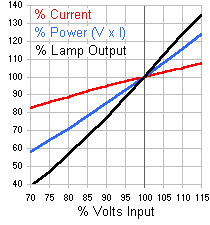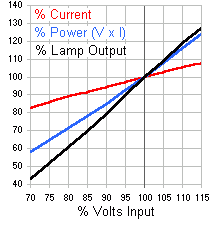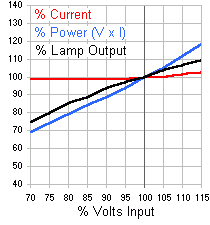|
The term "flicker" is the optical equivalent of dip, sag, surge, and swell i.e. all of the above wrapped up in one. Flicker simply denotes the sudden, often annoying change in brilliance in lighting (be it a single lamp or complete lighting system). It is not much use to the PQ investigator apart from indicating there may be a problem although flicker can, and often does exist in a perfectly sound installation. I have never seen anyone document why flicker is such a headache to the PQ investigator so we did some digging and a few experiments and came up with the following.
The part we are interested in is the value known as the Just Noticeable Difference (JND). All our senses have a value, the commonly known one being the ear as approximately 1-tenth. The eye is a lot more sensitive to change and has a JND value of approximately 1-sixtieth. Therefore, if the brilliance of a lamp changes by more than 1/60 it will be noticed. If this change occurs often it starts becoming annoying, and the greater the change the more the annoyance. As if the brilliance was not enough to contend with, the temperature of the filament also changes with a change in input voltage resulting in a change in the emitted visable spectrum. Most of the output from a typical incandescent lamp is infrared i.e. heat. The hotter the filament the more it emits useful visible light.
The temperature of the filament is also clearly reflected in the useful lamp output curve. Taking the ratio of change of output over input at approximately 2.4:1 a JND of 1/60 requires only a change of approximately 1/140 i.e. 0.7% or 1.6V at 230V nominal. The output from "daylight blue" lamps, and others with filter coatings, vary less with input voltage as the output tends to be limited to the spectrum of the filter. It can be noticed from the second graph that the output, once the temperature of the filament is high enough (from 100% onwards), starts increasing at roughly the same rate as the output.
The part to remember is that the brilliance needs to change relatively quickly otherwise the iris takes over and compensates for subtle or slow changes in light level. Halogen lamps, although being incandescents, have such a high thermal lag they hardly change in brilliance during short duration sags or swells. Small long term changes that are seen in standard incandescents are far more difficult to recognize in halogens again because of the thermal lag and are therefore ideal in combatting flicker problems. Recent 'tests' have revealed that even the 240V 100W versions with slightly thinner filaments (one is now in a fitting where a badly flickering standard incandescent once sat) prove very efficient in reducing the perception of flicker to almost negligible levels. Although 1Pu is the accepted measured level at which flicker is deemed "on the border of irritation", it must be remembered that it is a perception related problem. Some people are going to be more susceptible to flicker than others. It seems to be common, in an effort to reduce flicker complaints owing to this susceptibility, to find that the short term (Pst) levels are allowed at 1Pu with the long term (Plt) at 0.8Pu. This is fully explained in the section "Understanding the IEC-868 Flicker Curve". The presence of flicker does not necessarily indicate there is a potential hazard within the installation (and there usually isn't, but please read the next page), it is still a very real annoyance... for both the sufferer as well as the PQ investigator. Hopefully this little section has helped understand why. Flicker:- A Potential Fire Warning >>
© 19.11.01 |
 SYMPTOMS:
SYMPTOMS: We start by first understanding how the eye reacts. The long term dynamic range of the eye, the limits being from the faintest determinable flicker through to a blinding glare, is 1010. That's equivalent to 200dB. The iris playing a huge part in controlling the overall input onto the retina. Ok, this part most people know.
We start by first understanding how the eye reacts. The long term dynamic range of the eye, the limits being from the faintest determinable flicker through to a blinding glare, is 1010. That's equivalent to 200dB. The iris playing a huge part in controlling the overall input onto the retina. Ok, this part most people know. This effect is seen in the first graph which shows the percentage current changing by only about half the change in input voltage (the hotter a conductor, the higher its resistance). The power consumption (V x I) curve also reflects this and clearly indicates why the V2/R rule (usually applied to heating elements) cannot be applied to lighting (yet all the 'experts' involved with flicker do!).
This effect is seen in the first graph which shows the percentage current changing by only about half the change in input voltage (the hotter a conductor, the higher its resistance). The power consumption (V x I) curve also reflects this and clearly indicates why the V2/R rule (usually applied to heating elements) cannot be applied to lighting (yet all the 'experts' involved with flicker do!). The final category of lamps, these being the energy saving types which are usually based on gas discharge mechanisms (fluorescent, sodium, mercury vapour, etc.), are almost "flicker resistant". The curve shown indicates how the ballast maintains the current through the tube and how this regulates the output from the lamp. The ballast is what takes most of the extra voltage as can be seen from onwards of about +5% with the ballast showing signs of saturating. Such lamps require large changes in input voltage to have a visible output variation.
The final category of lamps, these being the energy saving types which are usually based on gas discharge mechanisms (fluorescent, sodium, mercury vapour, etc.), are almost "flicker resistant". The curve shown indicates how the ballast maintains the current through the tube and how this regulates the output from the lamp. The ballast is what takes most of the extra voltage as can be seen from onwards of about +5% with the ballast showing signs of saturating. Such lamps require large changes in input voltage to have a visible output variation.